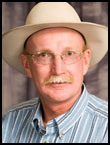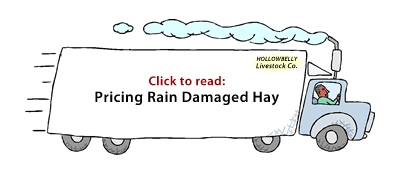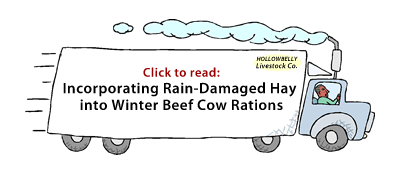
Ron Torell
Back to Basics
Make hay when the sun shines.
There wasn't a lot of sun shining in much of the Great Basin and Intermountain West during the month of June. Instead, unseasonably wet weather delivered as much as 4 inches (in.) of moisture to many hayfields during harvest. The result is thousands of tons of rain-damaged or late-maturity harvested beef hay on the market at reduced prices. In this issue of "Back to Basics" let's discuss rain-damaged hay.
Discoloration and bleaching is the least of our concerns relative to rain-damaged hay. In addition to hay harvested and baled with high moisture content posing the threat of fire in the stack due to spontaneous combustion, rain-damaged hay can lose quality in several ways, including mold, loss of protein and energy, as well as damage from excessive heating after harvest. Reduction in quality is dependent upon many factors, such as how far into the curing/drying process the hay was when the rain was received, how much rain was received, and for how long the rain persisted.
Drying conditions after rainfall stops also affect quality. Plant respiration will take place until it dries to less than 30% moisture. Rewetting the hay will restart the respiration process, which uses carbohydrates (lowering energy value).
We often have to mechanically turn hay to expedite the drying process. This mechanical process often causes leaf shatter and loss of leaves, which, in turn, results in reduced quality.
Wet hay promotes microbial activity and growth, which, in turn, results in lower quality and potentially moldy hay. Certain molds, when fed to livestock, can cause abortions in cattle and can cause other health risks, including reduced fertility in bulls. Avoiding the purchase and feeding of moldy hay is always the wisest choice; however, that option is not always possible.
Researchers at Iowa State University (ISU) provide a general guide for feeding rain-damaged hay, yet go on to state that these guidelines should not replace testing of hay. The ISU researchers suggest that newly cut hay receiving a light rain probably loses little quality. Nearly dry hay that receives a light to severe and extended rain may suffer significant quality loss. Dry-matter loss can be up to 5% per inch of rain, while digestibility can decrease up to 10%. The most significant loss will be in energy. Protein will also decrease; however, not as significantly as energy. Vitamin A content will also decrease.
An Oklahoma State University publication points out that mild and long-term rainfall, such as we saw last spring, will leach more soluble carbohydrates and nutrients than intensive short-term rainfall. Up to 50% of the dry matter removed might be soluble carbohydrates. This loss of carbohydrates equates to a loss of total digestible nutrients (TDN), also known as energy.
One year ago beef hay was priced at greater than $200 per ton. This year we can buy all we want for less than half that amount. Caution is warranted when purchasing severely rain-damaged hay and utilizing that hay in a beef cow ration. Every hay field is different and the loss of quality is variable. There is no way to establish value or balance a ration until you know what nutritive value is contained in the hay at time of feeding. Thus, the best advice is to spend the $30 to $50 and have hay tested at a commercial laboratory prior to purchasing and feeding (see sidebar stories: "Pricing Rain-Damaged Hay" and "Incorporating Rain-Damaged Hay into Winter Beef Cow Rations").
If you would like to discuss this article or simply would like to talk cows do not hesitate to contact Torell at 775-738-1721, Foster at 775-273-2923, McCuin at 775-237-5326, or Parsons at 541-523-6418.
Back to Basics, read more:
Comment on this article.
[Click here to go to the top of the page.]






